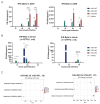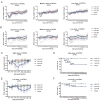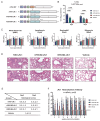Development of COVID-19 Vaccine Candidates Using Attenuated Recombinant Vesicular Stomatitis Virus Vectors with M Protein Mutations
- PMID: 40872776
- PMCID: PMC12390721
- DOI: 10.3390/v17081062
Development of COVID-19 Vaccine Candidates Using Attenuated Recombinant Vesicular Stomatitis Virus Vectors with M Protein Mutations
Abstract
Recombinant vesicular stomatitis virus (rVSV) is a promising viral vaccine vector for addressing the COVID-19 pandemic. Inducing mucosal immunity via the intranasal route is an ideal strategy for rVSV-based vaccines, but it requires extremely stringent safety standards. In this study, we constructed two rVSV variants with amino acid mutations in their M protein: rVSV-M2 with M33A/M51R mutations and rVSV-M4 with M33A/M51R/V221F/S226R mutations, and developed COVID-19 vaccines based on these attenuated vectors. By comparing viral replication capacity, intranasal immunization, intracranial injection, and blood cell counts, we demonstrated that the M protein mutation variants exhibit significant attenuation effects both in vitro and in vivo. Moreover, preliminary investigations into the mechanisms of virus attenuation revealed that these attenuated viruses can induce a stronger type I interferon response while reducing inflammation compared to the wild-type rVSV. We developed three candidate vaccines against SARS-CoV-2 using the wildtype VSV backbone with either wild-type M (rVSV-JN.1) and two M mutant variants (rVSV-M2-JN.1 and rVSV-M4-JN.1). Our results confirmed that rVSV-M2-JN.1 and rVSV-M4-JN.1 retain strong immunogenicity while enhancing safety in hamsters. In summary, the rVSV variants with M protein mutations represent promising candidate vectors for mucosal vaccines and warrant further investigation.
Keywords: SARS-CoV-2; live attenuated vaccine; mucosal immunity; vesicular stomatitis virus.
Conflict of interest statement
The authors declare no conflicts of interest.
Figures






Similar articles
-
Mucosal Delivery of Recombinant Vesicular Stomatitis Virus Vectors Expressing Envelope Proteins of Respiratory Syncytial Virus Induces Protective Immunity in Cotton Rats.J Virol. 2021 Feb 24;95(6):e02345-20. doi: 10.1128/JVI.02345-20. Print 2021 Feb 24. J Virol. 2021. PMID: 33408176 Free PMC article.
-
Assessment of Single-Cycle M-Protein Mutated Vesicular Stomatitis Virus as a Safe and Immunogenic Mucosal Vaccine Platform for SARS-CoV-2 Immunogen Delivery.Adv Sci (Weinh). 2024 Dec;11(47):e2404197. doi: 10.1002/advs.202404197. Epub 2024 Nov 11. Adv Sci (Weinh). 2024. PMID: 39526809 Free PMC article.
-
[Immunization of Mice with the pVAXrbd DNA Vaccine by Jet Injection Induces a Stronger Immune Response and Protection against SARS-CoV-2 Compared to Intramuscular Injection by Syringe].Mol Biol (Mosk). 2025 May-Jun;59(3):453-468. Mol Biol (Mosk). 2025. PMID: 40864861 Russian.
-
A Brighton Collaboration standardized template with key considerations for a benefit/risk assessment for the emergent vesicular stomatitis virus (VSV) viral vector vaccine for Lassa fever.Vaccine. 2025 Jun 11;58:127137. doi: 10.1016/j.vaccine.2025.127137. Epub 2025 May 13. Vaccine. 2025. PMID: 40367816 Review.
-
Live virus vaccines based on a vesicular stomatitis virus (VSV) backbone: Standardized template with key considerations for a risk/benefit assessment.Vaccine. 2016 Dec 12;34(51):6597-6609. doi: 10.1016/j.vaccine.2016.06.071. Epub 2016 Jul 6. Vaccine. 2016. PMID: 27395563 Free PMC article. Review.
References
-
- Kumar S.U., Priya N.M., Nithya S.R., Kannan P., Jain N., Kumar D.T., Magesh R., Younes S., Zayed H., Doss C.G.P. A review of novel coronavirus disease (COVID-19): Based on genomic structure, phylogeny, current shreds of evidence, candidate vaccines, and drug repurposing. 3 Biotech. 2021;11:198. doi: 10.1007/s13205-021-02749-0. - DOI - PMC - PubMed
-
- Fuchs J.D., Frank I., Elizaga M.L., Allen M., Frahm N., Kochar N., Li S., Edupuganti S., Kalams S.A., Tomaras G.D., et al. First-in-Human Evaluation of the Safety and Immunogenicity of a Recombinant Vesicular Stomatitis Virus Human Immunodeficiency Virus-1 gag Vaccine (HVTN 090) Open Forum Infect. Dis. 2015;2:ofv082. doi: 10.1093/ofid/ofv082. - DOI - PMC - PubMed
MeSH terms
Substances
Grants and funding
LinkOut - more resources
Full Text Sources
Medical
Miscellaneous

